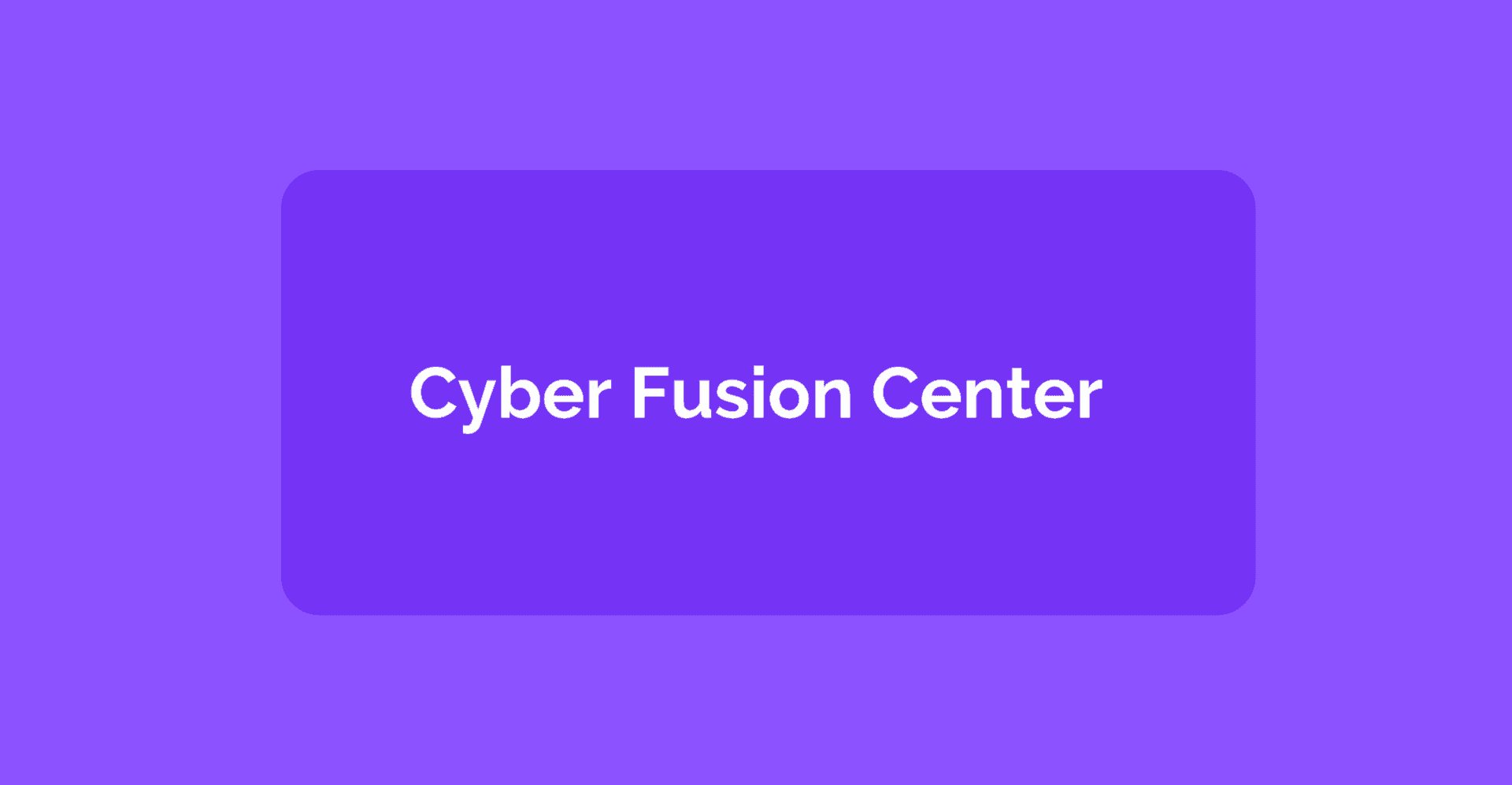Nov 8, 2021
Paul-Arthur
Jonville
The architecture of security operations is usually fragmented among different teams, such as security operation centers (SOC), computer security incident response teams (CSIRT), and physical security teams (access to data centers or patch panels, for instance). Their roles are divided between protecting, detecting, identifying, remediating, and investigating security incidents.
However, all of these teams and their preferred tools and technologies tend to work in silos, using tools unconnected or lacking semantical awareness. With the threats evolving, rising frequency, and worsening consequences, we can't work the way we did yesterday in security operations.
Agility, collaboration, and reactivity are paramount to prospering in this hostile environment. Organizations need to break the walls built between their teams. Collective action is necessary to share knowledge and prepare for the next attacks. To achieve this goal, the concept of Fusion Centers arose. The goal is to gather the relevant teams to approach a given issue holistically.
As cyberspace and the risks it induced grew in importance, a new concept appeared: the Cyber Fusion Center. It combines all security functions, such as threat intelligence, security orchestration, security automation, incident response, and every other relevant one, such as operatives' or physical security, into a single unit meant as a collaboration space.
This can represent a challenge to most companies. Still, to us, thanks to a Security Orchestration, Automation, and Response tool (SOAR), you can:
Overcome the fragmentation often characterizing security operations teams;
Embrace collective defense to counter threats properly;
This is why you should implement a cyber fusion center;
Break the walls and bring lots of benefits to your organization.
Enterprises are struggling with information siloes
Cyberspace threats are evolving at an increasingly rapid pace. More attacks are targeting organizations every day, and they are also becoming more varied and sophisticated.
In return, security operations had to adapt. For each problem arising, they afforded new tools and diversified their roles. The goal was to strengthen their security posture and gain visibility into various threats. Consequently, the structure tends to be divided into poles. Some focused on incident detection and qualification, and others on crisis management, forensics, and threat intelligence.
Furthermore, this structure segmented in poles involves a wide range of tools, some of which you surely know: Firewall, Antivirus, Security Information, Event Management platforms, Endpoint Detection and Response, Intrusion Detection and Protection Systems, Identity and Access Management systems, and so on. These tools aim to achieve tasks such as threat intelligence, incident detection, threat response, vulnerability management, and more.
Hence, with different missions, tools, and teams, every team tends to work independently from others, creating silos. These silos are walls forbidding teams to see what's happening on the other side, to be aware of the global picture. Moreover, it favors the fragmentation of goals; each follows their own and does not care about others or the common one. As a result, information is sequestred within every silo because of a lack of communication or inadequate integration. Ultimately, general efficiency will be affected.
Also, to those who would say, "Just afford an all-in-one product!" We've already said in a former article that we think a company can and should go for pinpoint solutions that serve a different purpose to adequately manage it thanks to a SOAR.
To achieve a higher-level understanding of the threat landscape, fragmentation must be eliminated. This is only possible when all the teams, tools, and processes within an organization work together—when walls are broken.
Collective defense with a cyber fusion center is critical
Why collective defense?
Cybersecurity threats are specific. One weak link can hamper a whole organization or industry. Recent cases illustrate this: Solarwinds or Microsoft Exchange faced breaches that swarmed across entire sectors. In other words, organizations and industries face the same threats and share the same consequences of an internal or external breach.
This hostile environment has created the need to shift how organizations construct their cybersecurity architecture, introducing a collective defense model to thwart various threats instead of following a passive and reactionary approach.
As strategists say, knowing yourself and your enemy is paramount to winning battles. Awareness of risks, threats, opportunities, and impacts relevant to an organization and its industry is crucial. However, this is impossible when different teams work separately and are unconnected. Data and knowledge are lost in the interstices between teams and tools.
In that way, collective defense is a collaborative strategy that requires organizations to defend against internal and external cyber threats.
For instance, in a collective defense model, the threat-hunting team can share its knowledge with the intelligence team to provide more intel on any new threat. This intel can then be shared with SOC teams as actionable intelligence. Therefore, it allows security teams to gain visibility into threats by providing information on different threats in a single place.
A collective defense system not only breaks silos within your organization but is also prone to foster collaborations across industries through strategic, tactical, and operational threat intelligence.
However, an approach promoting collaboration between security operations through intelligence sharing and coordinated threat response is only possible within a center, allowing fusion between every team.
What is a Cyber Fusion Center?
Security teams (SOC, CSIRT, or others) collect massive amounts of data from disparate sources daily. However, operations usually need to correlate these data to make them actionable. A cyber fusion center makes this correlation possible.
Fusion centers unite multiple teams to work as a single entity with common goals and real-time information sharing. When dealing with evolving cybercriminals and security threats, visibility enables organizations to identify suspicious patterns, quickly respond to them, and mitigate them more effectively.
A cyber fusion center federates all security functions, such as threat intelligence, threat hunting, threat response, incident response, and others, into a single platform.
Reactivity is critical when attacks can bring your organization down for hours or days. By breaking walls between your teams and allowing real-time data and knowledge sharing precisely, you're decreasing your reaction time and being more reactive and sharp in handling the threats.
Collaboration also helps to enrich threat knowledge. One main issue with data ingested by tools is its lack of contextualization. To fully understand the nature of a threat, one needs to have a dynamic vision of it. Data needs to be enriched with indicators of compromise, pieces of intel from threat intelligence, or the results from forensic teams.
This approach enables teams to share real-time strategic and tactical threat intelligence, increasing quality. Thus, a cyber fusion center improves the overall security architecture, resilience, reactivity, and prioritization in the face of growing threats.
It also provides decision-makers and stakeholders with a single source of truth for monitoring all critical data, allowing them to establish a common objective around their security functions.
It ensures that each team's knowledge is communicated in real time to everyone—humans or machines—in other teams for decision-making and prioritizing necessary actions.
In sum, building a fusion center allows your teams to collaborate remotely, foster a collective defense approach to better handle threats on a single integrated and modular platform-based system, and drive improved decision-making in incident response.
Enhance efficiency and seamless communication
A cyber fusion center can achieve numerous goals by federating security operations. Organizations can leverage security orchestration and automation to support integrations between multiple tools. This aids security teams in eliminating loopholes in their existing processes and quickly responding to threats. It combines and examines all the threat data generated from security tools in one place to deduce high-confidence actionable threat intelligence.
Automate Security Operations
At the heart of cyber fusion centers lies the SOAR. It allows the automation of the ingested raw data across multiple sources of your organization. Otherwise, such a task would require too much work in a field where each hour and human resources are scarce.
As we've already said, bringing SOAR to your teams has advantages in de-duplicating alerts, detection/response time, and prioritization. Moreover, a SOAR platform we promote aims to ease the burden because of its no-code operation. Workflows are created by simple drag-and-drop in a friendly UI/UX design to enhance the user experience.
In that way, a cyber fusion center facilitates cross-functional and cross-environment orchestration, offering the scalability and flexibility required to connect all the security processes across an organization. This increases security teams' reactivity and sharpness in tackling incoming attacks and enhances their knowledge of potential ones.
Eliminate silos across your organization
As we said, your security teams use different tools and processes to achieve different goals. However, the data each team collects can be particularly important for the other team. Fragmented operations make sharing these data tedious. With the help of automation, you can streamline these otherwise labor-intensive tasks. For instance, take the path between threat intelligence and triage, which usually involves different tools and teams. Automated processes will help contextualize the data the SIEMs are ingesting and avoid possible mistakes.
In sum, by breaking down the silos thanks to automating the sharing processes, the cyber fusion center enhances the general awareness of your security teams with a real-time information-sharing process.
Enable a collective defense posture
An attack against one part of your organization or even one outside company can have repercussions for you or many people. Collective defense goes hand in hand with breaking the walls between your teams. Everyone shares the same goal. Everyone can have essential pieces of intel. The gathering is the best way to overcome the most dangerous threats. Beyond breaking silos, the purpose of a cyber fusion center is to allow teams and organizations to collaborate through strategic and tactical threat intelligence sharing across organizations and industry-wide.
Contextualize segmented intelligence gathered across the teams
When combating fast-evolving and sophisticated threats, knowledge is critical. Deciphering signatures and having a dynamic conception of your environment is a noticeable advantage over the too often-seen static ones. Teams must be able to correlate the data they're ingesting with relevant intel. Connecting Endpoints IoC with logs from SIEMs and intel from Threat intelligence without having the tedious task of manual research saves vast amounts of time and labor for everyone in your teams.
In short, a cyber fusion center automates the contextualization of data on evolving threats by connecting the dots IoCs, TI, and TTPs, enabling teams to gain a crucial advantage over their enemies by enhancing their knowledge.
Therefore, organizations can benefit significantly from building bridges and breaking down silos in their security operations to strengthen their cybersecurity posture.
Maximize your potential with automation
To improve your security, you need to know yourself, alikes, and your enemies. To this end, sharing and enriching the data you collect inside and outside your company is paramount.
However, this knowledge is still isolated among different teams. We think we need to create a place to automate and enrich this sharing. This is the only way to improve an organization's overall security.
Create a cyber fusion center and orchestrate it with a SOAR. Automate the operations. This is how to empower your data to be dispersed among your teams. The integration of different security functions opens up the door to new possibilities and unique benefits like:
Orchestration across your organization —By leveraging integrations between various security functions and tools, your teams can build seamless workflows while minimizing overlaps and loopholes between the tools they use.
Data collection and sharing are automated. Automated and standardized processes across tools and teams prepare the data collection and sharing between relevant teams in real-time.
Advanced Threat Detection - Real-time intelligence and data sharing enhance your teams' contextual awareness and improve their capacity to detect incoming threats.
Automating end-to-end incidents —streamlined and standardized operations allow security teams to leverage automation to create workflows from detection to response and management
Boost overall productivity and security— The fusion of security operations accelerates incident detection and response time with less labor by facilitating and improving the quality of exchanges between every team. It improves resource allocation and reduces costs and risks.







